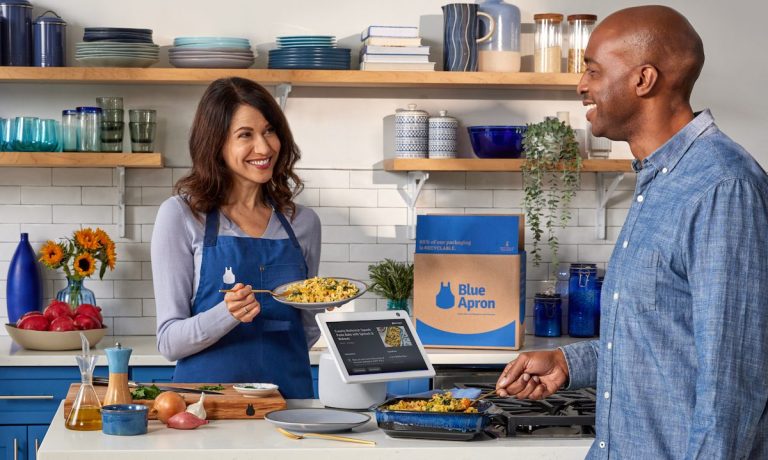
Blue Apron continues to incur losses while making moves toward long-term profitability.
Blue Apron announced Thursday (Feb. 10) a 7% year-over-year revenue decrease in the fourth quarter of 2021 and a $26.4 million net loss, nearly three times its $10 million Q4 2020 losses. Amid these losses, the company is working toward fulfillment center improvements to operate more efficiently and cost-effectively.
In an interview with PYMNTS, Blue Apron CEO Linda Findley discussed how the company’s fulfillment centers and its in-house kitchen operations set the company up for greater profitability in the long run.
“We have a huge amount of automation,” she said. “We have world class equipment in the facilities… We actually have the ability without a significant amount of capital infrastructure to lean into scale and growth and complexity for the next couple of years. The fact that we have this ability to do the individual portions ourselves creates margin advantage… The cost winds up being overall lower at scale.”
While some competitors purchase ingredients pre-packed, Blue Apron does so itself in facilities equipped with automated technologies, which both boosts profit margins and gives the company greater control over its foods, she said.
The company announced Monday (Feb. 14) a $5 million private placement investment, after which the company’s stock price fell roughly 9%.
In the Long Run
One of the ways that the company intends to make the economics of the model work is by generating more value from existing customers, rather than by relying on new customer acquisition.
“While I think the subscription model is important, it’s really more important that you’re … focus[ing] on the entire retention and engagement part of the channel,” said Findley.
In general, subscription commerce is on the rise, according to data from PYMNTS’ November 2021 study, the “Subscription Commerce Conversion Index: The Exclusive Access Effect Edition,” which drew from a survey of a census-balanced panel of more than 2,400 United States adults.
Read more: 12% of Consumers Use Retail Subscriptions to Gain Exclusive Access to Products
The study found that consumers’ total number of subscriptions is on the rise. In fact, the average number of subscriptions that consumers keep doubled between the first quarter of 2021 and the fourth from two-and-a-half to five. Additionally, total collective expenditure on retail subscription services nearly tripled in the same period from $5.5 billion to $15.1 billion.
Moreover, the survey results revealed that consumers’ top motivation for using retail subscriptions is that they believe that these services offer them access to higher-quality items than they can get from other sources, while the second-most-common reason is that they believe it is more convenient than shopping in a store.
“We’ve had seven straight quarters now and elevated customer engagement metrics,” said Findley. “And our intention is actually to keep those high while now leaning into customer growth on top of that.”
One and Done
One of the ways that Blue Apron is trying to make its offerings relevant to a greater number of consumers is by expanding beyond the subscription model to offer one-time-purchase items.
“Subscription will always be a core of what we do, and that actually is a great advantage for us, but we do see both the desire for some people to try the boxes without a subscription or maybe get special occasions boxes,” Findley said.
In December, the company announced a partnership with Amazon to offer non-subscription boxes that could be ordered through Alexa-enabled devices. As such, Findley noted that this one-off option “opens us up to other distribution” and “helps build a funnel” to reach new consumers.
Across food-related businesses, providers are looking for ways to meet consumers’ rising need for flexibility. Restaurants are providing a greater range of order fulfillment channels, and grocers are promising faster delivery times, with everyone attempting to offer convenient options that consumers can make fit into their lifestyles.
As such, one-time purchases could be a way for Blue Apron to offer its products to those who do not wish commit to the consistency of a subscription, although the channel is lower value overall for the meal kit provider.
Getting Personal
Looking ahead, Findley said she predicts meal kit providers will increasingly find their niche, growing more able to meet the needs of their specific audiences.
For instance, she noted that as providers’ supply chains become more efficient, they will be able to be nimbler when it comes to meeting their customers’ evolving needs. Additionally, one of the advantages of the direct-to-consumer (D2C) model is that providers can monitor these needs, analyzing internal data to understand their customers far better than they would be able to through third-party marketplaces.
“The food industry is … a massive industry, and you’re never going to have one winner-takes-all meal kit out there, just like you’re not going to have one grocery store, one restaurant out there,” Findley said. “But you are going to start to see a little bit more differentiation and audience-focus.”